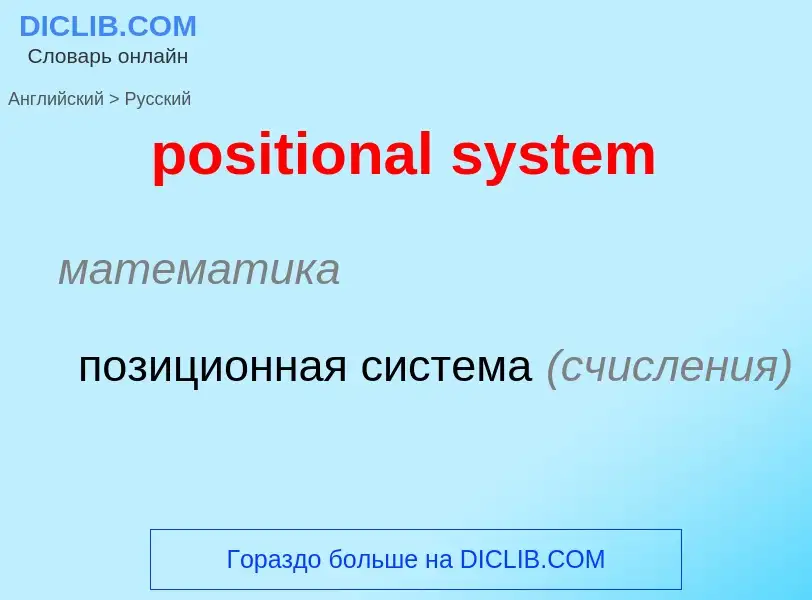Перевод и анализ слов искусственным интеллектом ChatGPT
На этой странице Вы можете получить подробный анализ слова или словосочетания, произведенный с помощью лучшей на сегодняшний день технологии искусственного интеллекта:
- как употребляется слово
- частота употребления
- используется оно чаще в устной или письменной речи
- варианты перевода слова
- примеры употребления (несколько фраз с переводом)
- этимология
positional system - перевод на русский
математика
позиционная система (счисления)
общая лексика
позиционное представление
общая лексика
взвешенный код
математика
преобразование системы счисления
[pə'ziʃ(ə)nəl]
общая лексика
позиционный
Смотрите также
прилагательное
общая лексика
позиционный
['pleisvælju:]
математика
разрядное
поместное значение (цифры)
значение разрядное
общая лексика
GPS
система глобального позиционирования (через спутниковые ретрансляторы) СГП
спутниковая система позиционирования, позволяющая с помощью специального приёмника осуществить быстрое автоматическое определение координат в любой точке мира (точность колеблется от 10 до 100 м) и скорости перемещения различных объектов на поверхности Земли и в воздушном пространстве. Состоит из 24 спутников, принадлежащих правительству США. Использует частоту 1575,42 МГц для гражданских целей и 1227,6 МГц - для военных. Спутники группировки GPS передают также сигналы точного времени, основанные на собственных бортовых атомных часах. Приёмники GPS производятся в виде навигационных систем для автомобилей, а также модулей, устанавливаемых в карманные ПК и сотовые телефоны
Смотрите также
общая лексика
кроветворная система
Википедия
Positional notation (or place-value notation, or positional numeral system) usually denotes the extension to any base of the Hindu–Arabic numeral system (or decimal system). More generally, a positional system is a numeral system in which the contribution of a digit to the value of a number is the value of the digit multiplied by a factor determined by the position of the digit. In early numeral systems, such as Roman numerals, a digit has only one value: I means one, X means ten and C a hundred (however, the value may be negated if placed before another digit). In modern positional systems, such as the decimal system, the position of the digit means that its value must be multiplied by some value: in 555, the three identical symbols represent five hundreds, five tens, and five units, respectively, due to their different positions in the digit string.
The Babylonian numeral system, base 60, was the first positional system to be developed, and its influence is present today in the way time and angles are counted in tallies related to 60, such as 60 minutes in an hour and 360 degrees in a circle. Today, the Hindu–Arabic numeral system (base ten) is the most commonly used system globally. However, the binary numeral system (base two) is used in almost all computers and electronic devices because it is easier to implement efficiently in electronic circuits.
Systems with negative base, complex base or negative digits have been described. Most of them do not require a minus sign for designating negative numbers.
The use of a radix point (decimal point in base ten), extends to include fractions and allows representing any real number with arbitrary accuracy. With positional notation, arithmetical computations are much simpler than with any older numeral system; this led to the rapid spread of the notation when it was introduced in western Europe.




![Emblem of the [[50th Space Wing]] Emblem of the [[50th Space Wing]]](https://commons.wikimedia.org/wiki/Special:FilePath/50th Space Wing.png?width=200)





![Ground monitor station used from 1984 to 2007, on display at the [[Air Force Space and Missile Museum]] Ground monitor station used from 1984 to 2007, on display at the [[Air Force Space and Missile Museum]]](https://commons.wikimedia.org/wiki/Special:FilePath/GPS monitor station.jpg?width=200)
![antenna]] is mounted on the roof of a hut containing a scientific experiment needing precise timing. antenna]] is mounted on the roof of a hut containing a scientific experiment needing precise timing.](https://commons.wikimedia.org/wiki/Special:FilePath/GPS roof antenna dsc06160.jpg?width=200)
![Unlaunched GPS block II-A satellite on display at the [[San Diego Air & Space Museum]] Unlaunched GPS block II-A satellite on display at the [[San Diego Air & Space Museum]]](https://commons.wikimedia.org/wiki/Special:FilePath/Global Positioning System satellite.jpg?width=200)

![Attaching a GPS guidance kit to a [[dumb bomb]], March 2003 Attaching a GPS guidance kit to a [[dumb bomb]], March 2003](https://commons.wikimedia.org/wiki/Special:FilePath/US Navy 030319-N-4142G-020 Ordnance handlers assemble Joint Direct Attack Munition (JDAM) bombs in the forward mess decks.jpg?width=200)
![[[M982 Excalibur]] GPS-guided [[artillery shell]] [[M982 Excalibur]] GPS-guided [[artillery shell]]](https://commons.wikimedia.org/wiki/Special:FilePath/XM982 Excalibur inert.jpg?width=200)
